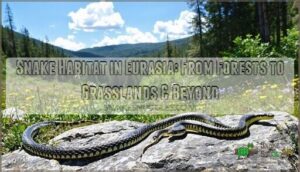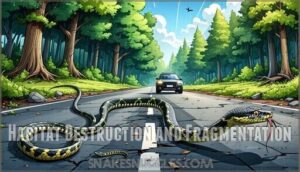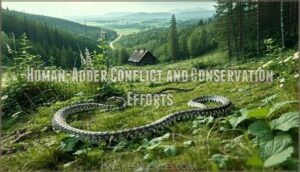This site is supported by our readers. We may earn a commission, at no cost to you, if you purchase through links.

European adders alone cover over 11,000km across this range – talk about frequent flyers. These snakes thrive in chalky downs where calcium-rich soils provide perfect shelter, Mediterranean forests with their warm microclimates, and temperate broadleaf forests offering abundant prey under protective canopies.
Wetlands with fluctuating water tables create rich hunting grounds, while meadows and grasslands serve as snake highways – though habitat fragmentation threatens these corridors.
Each habitat offers unique advantages: rock crevices for hiding, sun-warmed slopes for temperature regulation, and diverse prey communities that keep snake populations healthy across this vast continent.
Table Of Contents
- Key Takeaways
- Types of Eurasian Snake Habitats
- Habitat of The European Adder
- Geographical Distribution of Snakes in Eurasia
- Factors Shaping Snake Habitat and Evolution
- Snake Communities in Eurasia
- Impact of Human Activities on Snake Habitats
- Conservation of Eurasian Snake Habitats
- Frequently Asked Questions (FAQs)
- Which European countries have snakes?
- Where do snakes live in continents?
- Which is the only snake-free continent in the world?
- How many species of snakes are there in Europe?
- What is the largest snake in Europe?
- Why do European snakes need to be protected?
- Do snakes live in polluted areas?
- Are Aesculapian snakes endangered?
- Why do snakes live in a dune ecosystem?
- Are there any snakes native to Europe?
- Conclusion
Key Takeaways
- You’ll find European adders thriving across an incredible 11,000km range – from Scotland’s rocky moors to Mongolia’s grasslands – making them the world’s most widely distributed snake species.
- Your local snake populations face serious threats from habitat fragmentation, agricultural expansion, and climate change that’s forcing species to migrate northward faster than they can adapt.
- You’ll discover Eurasia’s snakes have mastered diverse habitats including chalky downs with calcium-rich soils, Mediterranean forests, wetlands, and temperate grasslands.
- You can support snake conservation through protected areas, habitat restoration programs, and community education efforts that reduce human-snake conflicts while preserving these essential ecosystem predators.
Types of Eurasian Snake Habitats
You’ll discover that Eurasian snakes have adapted to an impressive variety of habitats, from sun-baked rocky hillsides to lush forest floors.
Each environment offers unique challenges and opportunities that have shaped these remarkable reptiles over millions of years, leading to remarkable adaptations.
Chalky Downs and Rocky Hillsides
Chalk-rich landscapes create perfect snake real estate across Eurasia.
These limestone havens offer snakes everything they need: shelter, warmth, and perfect drainage
These ancient hillsides offer ideal soil composition and rocky shelters that support thriving adder habitats and hillside biodiversity.
You’ll discover three key features:
- Calcium-rich soils support diverse plant communities
- Natural rock crevices provide essential predator avoidance hideouts
- Sun-warmed slopes create ideal basking spots for thermoregulation.
These environments showcase how Eurasian snakes adapt brilliantly to varied terrain.
Meadows and Grasslands
Grassland snakes like the grass snake and meadow viper thrive in Eurasia’s meadows, where prey availability supports diverse meadow biodiversity.
These temperate grasslands offer perfect hunting grounds, but habitat fragmentation threatens Eurasian snakes.
Conservation strategies focus on protecting these essential ecosystems from agricultural expansion.
One key factor is the availability of essential retreat sites for these snakes.
Your local meadow might host more snake distribution than you’d expect!
Wetlands With Dry Ground
You’ll find wetlands with dry ground offer the best of both worlds for Eurasian snakes.
These habitats feature fluctuating water tables and varying soil moisture levels, creating perfect conditions for species that need flexibility in their living arrangements.
- Elevated patches of dry land surrounded by seasonal flooding areas
- Dense ground cover of sedges and rushes providing excellent camouflage
- Fluctuating water table creating diverse microhabitats throughout the year
- Rich wetland ecology supporting abundant prey like frogs and small mammals
- Mixed dry landforms with scattered pools and marshy depressions
Mediterranean Forests
Mediterranean forests across Eurasia create perfect snake habitats with their warm, diverse ecosystems.
These woodlands shelter species like the Northern Pine Snake, but they’re facing serious threats.
Forest fires tear through these areas more frequently, while climate impacts shift temperatures and rainfall patterns.
Habitat fragmentation from human development breaks up continuous forest areas.
However, species adaptation helps snakes survive changing conditions.
Conservation strategies focus on protecting remaining Mediterranean forests and creating wildlife corridors to connect fragmented areas, which is crucial for the snakes’ survival in these diverse ecosystems with warm conditions.
Temperate Broadleaf Forests
Diversity thrives beneath the forest canopy, where temperate broadleaf forests create perfect snake habitat conditions across Eurasia.
You’ll discover species moving through leaf litter and utilizing prey abundance from diverse tree species.
Despite forest fragmentation threatening these ecosystems, seasonal changes provide year-round shelter and hunting opportunities for various snake populations.
- Leaf litter creates cozy hideouts where snakes feel secure and protected
- Forest canopy offers natural temperature control that snakes desperately need
- Prey abundance means dinner’s always served in these woodland restaurants
Temperate Grasslands
As you leave the forest canopy behind, temperate grasslands stretch endlessly before you, home to grass snakes and meadow vipers.
These open habitats offer abundant rodent prey, but habitat fragmentation from agriculture threatens snake populations.
Grazing impact alters vegetation structure, while conservation strategies focus on maintaining corridor connectivity.
You’ll find these resilient grassland snakes adapting to human-modified landscapes across Eurasia.
Habitat of The European Adder
You’ll find the European adder thriving across an impressive range from the British Isles all the way to Siberia, making it one of the world’s most widely distributed snakes.
This adaptable viper has mastered the art of living in everything from heathlands and woodlands to moors and grasslands, proving that sometimes being flexible is the key to evolutionary success.
Geographic Range Across Eurasia
You’ll discover the European adder’s incredible Eurasian snake range spans over 11,000km—from Scotland’s misty highlands to Mongolia’s vast steppes.
This remarkable geographic range makes it the world’s most northerly snake, thriving across diverse climate zone impact areas.
Their species distribution shifts showcase nature’s adaptability, conquering biogeographic boundaries that would challenge most reptiles throughout Eurasia.
These snakes are known to thrive in diverse terrains and climates.
Diverse Color Patterns and Camouflage
European adders showcase remarkable color polymorphism across Eurasia’s snake habitat, displaying brown, gray, and black variations that enhance camouflage effectiveness.
This habitat matching isn’t just pretty—it’s survival gold for predator avoidance.
Their evolutionary significance lies in adaptation through coloration and patterns.
Here’s how their camouflage works:
- Background matching – Colors blend with local terrain
- Pattern disruption – Zigzag designs break body outline
- Seasonal adaptation – Darker morphs absorb heat better
- Geographic variation – Northern populations often darker
Adaptation to Various Biomes
You’ll find European adders are master adapters, shifting their Color Adaptation and behavior across Eurasia’s diverse biomes.
Their Climatic Tolerance lets them thrive from Britain’s moors to Siberian forests through Niche Specialization.
Seasonal Activity patterns and Burrowing Habits help them survive extreme temperatures while maintaining their Eurasia snake habitat dominance.
To guarantee their well-being, mimicking their natural environment, including providing proper UVB lighting, is vital.
| Biome Type | Color Adaptation | Behavioral Changes | Survival Strategy |
|---|---|---|---|
| Rocky Hillsides | Gray-brown tones | Increased basking | Rock crevice shelter |
| Forest Floor | Darker patterns | Enhanced climbing | Tree bark camouflage |
| Grasslands | Lighter coloration | Ground hunting | Vegetation blending |
| Wetland Edges | Variable shades | Swimming ability | Amphibious lifestyle |
Hibernation and Basking Sites
Winter survival means everything for European adders in temperate zones across Eurasia.
These resourceful snakes practice communal hibernation, crowding together in rocky crevices or abandoned burrows for shared warmth. You’ll witness their clever thermoregulation needs through strategic basking behavior on sunny winter days.
Site fidelity keeps them returning to proven microhabitat selections year after year. Adders benefit from having a dedicated basking platform available.
- Stone walls and rock piles creating perfect winter refuges
- South-facing slopes maximizing precious solar exposure
- Underground burrows offering frost-free sanctuary zones
Terrestrial and Climbing Abilities
After warming up from hibernation, you’ll find European adders are surprisingly versatile movers.
These terrestrial locomotion experts navigate rocky substrates with ease, but they’re also skilled climbers.
You’ll spot them scaling trees and boulders using impressive climbing speed and arboreal adaptations.
Their vertical habitat use isn’t just show-off behavior—it’s smart hunting strategy that keeps them hidden from both prey and predators across Eurasia’s diverse snake habitats.
Geographical Distribution of Snakes in Eurasia
You’ll find snakes distributed across Eurasia’s vast landmass spanning from Portugal to North Korea, with over 74 species adapted to dramatically different climates and elevations.
The Palearctic and Indomalayan biogeographical domains create a fascinating meeting point where European and Asian snake species have exchanged and evolved over millions of years, forming a unique area of exchange.
Palearctic and Indomalayan Biogeographical Realms
Throughout Eurasia’s vast expanse, you’ll encounter two major biogeographic boundaries that shape snake habitat distribution.
The Palearctic region spans northern areas while the Indomalayan region covers tropical zones, creating distinct biomes with unique conservation priorities.
Key characteristics of these regions include:
- Palearctic diversity: Over 500 snake species across Mediterranean and Central Asian habitats
- Indomalayan richness: 700+ species in tropical forests and monsoon climates
- Region overlap: Complex boundaries where species distribution patterns intersect
- Climate influence: Temperature and precipitation drive habitat suitability across biomes
- Conservation priorities: Hotspots require targeted protection for snake habitats
Within the tropical zones, the Indomalayan wildlife includes diverse reptile species like the King Cobra.
Exchange of Faunas Between Europe and Asia
You’ll discover how Faunal Exchange between Europe and Asia created natural highways for reptile species.
Biogeographic Barriers weakened during warmer periods, allowing Species Dispersal across continents.
These Migration Patterns shaped today’s snake habitats throughout Eurasia.
| Migration Period | Key Species Movement |
|---|---|
| Miocene Warming | Thermophilic snakes spread westward |
| Pleistocene Cooling | Cold-adapted species migrated south |
| Modern Era | Climate Influence drives range shifts |
Role of The Paratethys Sea in Facilitating Migration
The ancient Paratethys Sea created migration-highways that shaped Eurasian reptiles forever.
This massive inland sea acted like nature’s conveyor belt, opening land bridges during low water periods that allowed snake dispersal between continents.
When sea levels dropped, stepping-stone corridors connected Asia and Europe, letting species evolution unfold across new biomes.
Climate influence determined when these aquatic gateways opened or closed, controlling snake habitat expansion throughout Eurasia’s diverse landscapes.
The aquatic gateways played a crucial role in the evolution of Eurasian reptiles, as they allowed for the exchange of species between continents.
Impact of Climate Change on Snake Distribution
Climate change is reshaping snake distribution across Eurasia like a slow-motion earthquake.
Range shifts push venomous species northward, while phenological changes alter hibernation patterns and activity seasons.
Habitat suitability models predict up to 70% reduction in suitable areas for some species by 2070.
Extinction risks climb as habitat loss accelerates, yet certain adaptation strategies help resilient species colonize new territories, creating unexpected human-wildlife encounters.
Factors Shaping Snake Habitat and Evolution
You’ll discover that snake evolution in Eurasia wasn’t just random chance—it’s a fascinating story shaped by ancient climate shifts, moving continents, and fierce competition for survival.
These forces worked together like master sculptors, carving out the incredible diversity of snake species we see across this vast region today, a result of fierce competition for survival.
Miocene Climatic Optimum and Its Effects
Around 17-14 million years ago, you’d witness something remarkable happening across Eurasia.
The Miocene Climatic Optimum brought temperatures 3-6°C warmer than today, creating perfect conditions for thermophilic snake spread.
Heat-loving pythons and cobras suddenly called Germany home! This biome expansion opened new doors for habitat colonization as lush forests and wetlands stretched northward.
However, when climatic cooling impact hit around 14 million years ago, these tropical visitors disappeared.
The evolutionary pressures from this dramatic climate change shaped modern snake adaptation strategies, forever altering snake habitat diversity across Eurasia.
Paleogeographic Changes and Faunal Exchange
The Paratethys Regression dramatically reshaped snake habitats across Eurasia during the Miocene.
As this ancient sea retreated, Land Bridge Formation connected previously isolated regions, enabling unprecedented Species Dispersal. European adder ancestors navigated these new corridors alongside other reptiles.
Climate Oscillations and shifting Biogeographic Barriers created migration highways between continents.
You’ll find these paleogeographic changes fundamentally altered modern snake distribution patterns throughout Eurasia’s diverse landscapes.
Competition and Ecological Interactions
Two species can’t occupy the same niche forever—that’s competitive exclusion in action.
Sympatric species in Eurasia solve this through niche partitioning, dividing resources like hunting grounds or prey types.
Resource competition drives these interspecific interactions, forcing snakes to specialize.
You’ll find predator avoidance strategies also shape ecological niches.
This complex dance of snake ecology across snake habitat in Eurasia guarantees multiple species coexist without stepping on each other’s tails.
Adaptation to Environmental Changes
Survival masters, snakes have developed remarkable tricks to thrive despite environmental upheavals across Eurasia.
Their camouflage evolution helps them vanish into changing landscapes, while behavioral shifts let them adjust daily routines.
Here’s how they adapt:
- Migration patterns guide snakes to safer territories when climate change transforms their original snake habitat
- Genetic adaptations develop over generations, creating specialized traits for new environments
- Niche differentiation reduces competition by specializing in unique ecological roles within Eurasian ecosystems
Snake Communities in Eurasia
You’ll discover that Eurasia hosts an incredible variety of snake communities, from tiny burrowing species that look like earthworms to massive six-foot racers that can outrun most predators.
These diverse snake families have evolved together over millions of years, creating complex ecosystems where each species fills its own unique niche—though human activities are now reshaping these ancient communities faster than snakes can adapt to their new environments with unique niche.
Diversity of Snake Families and Genera
Eurasia’s snake diversity spans multiple families with distinct genus characteristics.
You’ll find venomous vipers with venom variations, non-venomous colubrids, and primitive blind snakes across different snake genera.
This species richness reflects millions of years of evolutionary history, with family phylogeny showing how snake families adapted to Eurasia’s varied landscapes through specialized snake taxonomy.
Evolution of Modern Snake Communities
You’ll discover how adaptive radiation shaped Eurasia’s snake communities during the Miocene epoch.
Climatic shifts triggered niche differentiation, allowing snakes to evolve specialized survival strategies across diverse habitats.
This evolutionary journey created today’s remarkable genetic diversity, though modern conservation implications highlight the fragility of these ancient adaptation processes that built Eurasia’s slithering success stories.
Some species showcase convergent body plans with lizards due to similar ecological pressures.
Heterogeneous Snake Fauna Across Eurasia
You’ll find Eurasian snake communities showcase remarkable diversity across continents.
European snakes demonstrate exceptional species richness through evolutionary history spanning millions of years.
Each habitat supports specialized snakes with unique conservation status requirements:
- Palearctic regions host cold-adapted vipers with distinct niche partitioning strategies
- Indomalayan zones shelter arboreal specialists showing incredible habitat specificity
- Mountain ranges preserve endemic species reflecting ancient biogeographic patterns
This heterogeneous fauna creates nature’s most complex snake puzzle!
Impact of Human Expansion on Snake Habitats
Human expansion’s relentless march fragments Eurasia’s snake habitats like a jigsaw puzzle missing pieces.
You’ll witness urbanization effects and agricultural expansion slicing through ancient territories, while road mortality claims countless lives.
Pollution impacts further degrade these ecosystems, creating a perfect storm of challenges for snake survival.
| Human Activity | Primary Impact | Snake Response |
|---|---|---|
| Habitat Fragmentation | Isolated populations | Reduced genetic diversity |
| Urbanization Effects | Habitat loss | Migration to unsuitable areas |
| Agricultural Expansion | Prey reduction | Altered feeding patterns |
| Road Mortality | Direct fatalities | Behavioral avoidance of crossing |
Impact of Human Activities on Snake Habitats
You’re witnessing one of the most significant threats to Eurasia’s snake populations as human activities reshape their ancient habitats at an unprecedented pace.
From urban sprawl fragmenting migration routes to climate change forcing species into new territories, these pressures create a perfect storm that’s pushing many snake communities toward local extinction.
Habitat Destruction and Fragmentation
You’ll witness firsthand how habitat destruction fragments Eurasia’s snake communities into isolated patches.
Agricultural expansion and urbanization impact create deadly obstacles that force snakes across dangerous roads, leading to road mortality.
Human expansion transforms continuous forests into scattered fragments, disrupting natural movement patterns.
- Habitat loss eliminates critical breeding and feeding areas
- Forest degradation reduces shelter availability and prey abundance
- Road mortality kills snakes attempting habitat connections
- Agricultural expansion replaces natural habitats with monocultures
Climate Change and Its Effects on Snakes
Climate change forces snakes across Eurasia into a survival game of musical chairs.
You’ll see range shifts as species chase cooler temperatures northward, while extreme weather disrupts hibernation patterns and prey availability.
Some snakes adapt through genetic changes, but many can’t keep pace with rapidly warming climates, leaving entire populations stranded, facing a desperate game of survival.
Human-Adder Conflict and Conservation Efforts
Addressing conflicts between the European adder (Vipera berus) and people requires balanced conservation policies that protect both species.
You’ll find snakebite mitigation works best through public education about adder behavior and habitat preferences. When human expansion threatens snake territories, adder relocation programs help reduce encounters while preserving populations.
For enhanced safety, consider exploring specialized snake bite protection.
- Prevention strategies: Wear protective footwear in known adder habitats
- Safe removal: Contact wildlife experts for professional adder relocation services
- Habitat protection: Support conservation efforts that prevent further habitat loss
- Community education: Share accurate information to improve public perception of these beneficial predators
Education and Awareness for Snake Conservation
Beyond addressing conflicts, Public Awareness Campaigns and School Education Programs transform how you view snakes in Eurasia.
These education efforts help you appreciate snakes’ ecological importance, Mitigating Human-Snake Conflict through understanding rather than fear.
Citizen Science Initiatives let you contribute to snake conservation research while Responsible Tourism Practices protect fragile habitats.
Your awareness becomes conservation action.
Conservation of Eurasian Snake Habitats
You’re not just watching Eurasian snakes disappear—you’re witnessing entire ecosystems unravel as their habitats vanish under human pressure.
Fortunately, conservationists across Eurasia are fighting back with protected areas, restoration programs, and cutting-edge research that’s giving these serpentine survivors a fighting chance.
Protected Areas and National Parks
You’ll find protected areas across Eurasia serve as vital refuges where snake populations thrive without human interference.
Park effectiveness depends on maintaining habitat connectivity through buffer zones that link fragmented landscapes.
These sanctuaries combat poaching impacts while managing ecotourism effects carefully.
Conservation strategies within protected areas balance visitor access with wildlife protection, ensuring habitat restoration continues.
Snake habitats flourish when parks maintain natural processes and minimize disturbance.
Habitat Restoration and Reintroduction Programs
When habitat restoration meets reintroduction methods, you’re basically playing matchmaker between displaced snakes and their rebuilt homes.
These conservation efforts tackle habitat loss across Eurasia through strategic ecosystem repair.
Here’s how habitat engineering works its magic:
- Controlled burns create mosaic patterns that balance basking spots with shelter
- Invasive species removal opens up vital nesting and refuge areas
- Head-starting programs raise captive snakes to reduce predation vulnerability
- Radio-tracking technology monitors released individuals for survival rates
Success demands patience—species monitoring shows older snakes adapt better than juveniles, while biodiversity conservation requires releasing at least 100 individuals for viable populations.
Research and Monitoring of Snake Populations
You’ll need accurate data to protect snake populations effectively.
Snake Tracking technology like GPS collars and camera traps reveals Population Trends across Eurasia’s diverse landscapes.
Scientists use Habitat Mapping to identify critical areas, while Species Identification through genetic analysis guides targeted Conservation Strategies.
Citizen scientists contribute valuable observations, creating thorough datasets that inform protection efforts against habitat loss throughout the region.
Effective snake conservation relies on advanced tracking device systems to monitor and understand snake behavior.
Community Engagement and Education for Conservation
When you’re passionate about snake conservation, your involvement makes all the difference.
Join citizen science projects to track populations and support habitat restoration efforts.
Public awareness grows through education initiatives and community outreach programs that build environmental literacy.
Attend workshops, participate in guided nature walks, and practice responsible tourism in snake habitats.
Your community engagement creates ripple effects, fostering coexistence and protecting these essential predators for future generations.
Frequently Asked Questions (FAQs)
Which European countries have snakes?
Like a sprawling tapestry across the continent, you’ll find snakes in virtually every European country.
From Portugal’s coastal regions to Russia’s vast territories, the UK’s countryside to Greece’s islands, snakes thrive throughout Europe’s diverse landscapes.
Where do snakes live in continents?
You’ll discover snakes thriving across all continents except Antarctica.
They’ve adapted to deserts, rainforests, grasslands, mountains, and wetlands.
From Arctic vipers in northern regions to tropical pythons in equatorial zones, these reptiles have conquered diverse habitats worldwide.
Which is the only snake-free continent in the world?
Antarctica’s the only continent completely free from snakes.
You’ll never worry about slithering surprises there since the icy temperatures and harsh conditions make it impossible for any snake species to survive naturally.
How many species of snakes are there in Europe?
Europe’s snake scene isn’t a slithering circus, but you’ll find around 50 species calling this continent home.
That number includes venomous vipers, harmless grass snakes, and everything between—quite the diverse reptilian neighborhood, with a diverse range of species.
What is the largest snake in Europe?
You’ll find two snakes competing for Europe’s largest title: the Aesculapian snake and Caspian whipsnake. Both typically reach around 5 feet long, making them impressive yet manageable neighbors.
Why do European snakes need to be protected?
Like canaries in coal mines, you’ll find European snakes facing a perfect storm of threats that require your protection efforts.
Habitat destruction, climate change, and human activities threaten their survival, making conservation essential for maintaining biodiversity and ecosystem balance.
Do snakes live in polluted areas?
You’ll find snakes avoiding heavily polluted areas since they can’t handle toxic chemicals well.
They need clean environments for hunting, breathing, and reproduction—pollution disrupts their food chains and causes health problems.
Are Aesculapian snakes endangered?
Exploring conservation waters, you’ll find Aesculapian snakes aren’t globally endangered—they’re classified as "least concern" by IUCN.
However, they’re critically endangered in Germany and face regional threats from habitat loss across their range.
Conservation efforts focus on the species conservation status to protect these endangered snakes.
Why do snakes live in a dune ecosystem?
Dunes offer snakes thermal regulation through sandy surfaces that heat quickly for basking and cool rapidly for shelter.
You’ll find loose sand provides easy burrowing opportunities, while sparse vegetation creates perfect hunting grounds for small prey like rodents and lizards, which is ideal for hunting.
Are there any snakes native to Europe?
Surprisingly, Europe hosts over 74 native snake species.
You’ll find common European adders zigzagging across heathlands, grass snakes swimming near wetlands, and Aesculapian snakes climbing trees—proving Europe’s surprisingly diverse serpent population.
Conclusion
Understanding snake habitat in Eurasia reveals nature’s remarkable adaptability story.
You’ve discovered how these resilient creatures navigate everything from Scotland’s windswept moors to Mongolia’s vast steppes, making homes wherever conditions allow survival.
Yet their future hangs in the balance as human activities increasingly fragment these ancient corridors.
By supporting conservation efforts and habitat protection, you’re helping preserve this incredible snake habitat in Eurasia for generations to come.


















